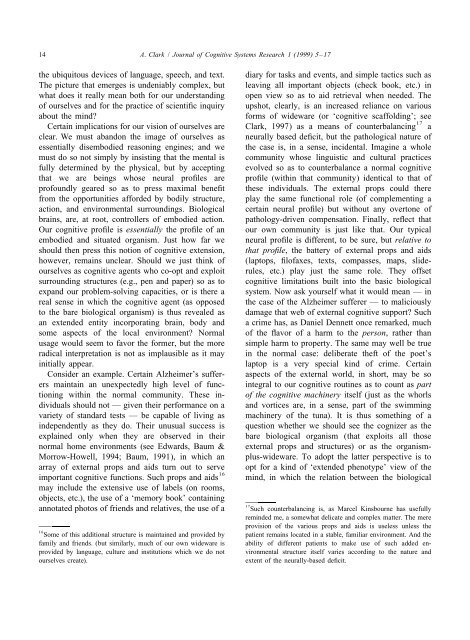Clark, Andy - Where brain body and world collide.pdf
Clark, Andy - Where brain body and world collide.pdf
Clark, Andy - Where brain body and world collide.pdf
You also want an ePaper? Increase the reach of your titles
YUMPU automatically turns print PDFs into web optimized ePapers that Google loves.
14 A. <strong>Clark</strong> / Journal of Cognitive Systems Research 1 (1999) 5 –17<br />
the ubiquitous devices of language, speech, <strong>and</strong> text. diary for tasks <strong>and</strong> events, <strong>and</strong> simple tactics such as<br />
The picture that emerges is undeniably complex, but leaving all important objects (check book, etc.) in<br />
what does it really mean both for our underst<strong>and</strong>ing open view so as to aid retrieval when needed. The<br />
of ourselves <strong>and</strong> for the practice of scientific inquiry upshot, clearly, is an increased reliance on various<br />
about the mind?<br />
forms of wideware (or ‘cognitive scaffolding’; see<br />
Certain implications for our vision of ourselves are<br />
17<br />
<strong>Clark</strong>, 1997) as a means of counterbalancing a<br />
clear. We must ab<strong>and</strong>on the image of ourselves as neurally based deficit, but the pathological nature of<br />
essentially disembodied reasoning engines; <strong>and</strong> we the case is, in a sense, incidental. Imagine a whole<br />
must do so not simply by insisting that the mental is community whose linguistic <strong>and</strong> cultural practices<br />
fully determined by the physical, but by accepting evolved so as to counterbalance a normal cognitive<br />
that we are beings whose neural profiles are profile (within that community) identical to that of<br />
profoundly geared so as to press maximal benefit these individuals. The external props could there<br />
from the opportunities afforded by bodily structure, play the same functional role (of complementing a<br />
action, <strong>and</strong> environmental surroundings. Biological certain neural profile) but without any overtone of<br />
<strong>brain</strong>s, are, at root, controllers of embodied action. pathology-driven compensation. Finally, reflect that<br />
Our cognitive profile is essentially the profile of an our own community is just like that. Our typical<br />
embodied <strong>and</strong> situated organism. Just how far we neural profile is different, to be sure, but relative to<br />
should then press this notion of cognitive extension, that profile, the battery of external props <strong>and</strong> aids<br />
however, remains unclear. Should we just think of (laptops, filofaxes, texts, compasses, maps, slideourselves<br />
as cognitive agents who co-opt <strong>and</strong> exploit rules, etc.) play just the same role. They offset<br />
surrounding structures (e.g., pen <strong>and</strong> paper) so as to cognitive limitations built into the basic biological<br />
exp<strong>and</strong> our problem-solving capacities, or is there a system. Now ask yourself what it would mean — in<br />
real sense in which the cognitive agent (as opposed the case of the Alzheimer sufferer — to maliciously<br />
to the bare biological organism) is thus revealed as damage that web of external cognitive support? Such<br />
an extended entity incorporating <strong>brain</strong>, <strong>body</strong> <strong>and</strong> a crime has, as Daniel Dennett once remarked, much<br />
some aspects of the local environment? Normal of the flavor of a harm to the person, rather than<br />
usage would seem to favor the former, but the more simple harm to property. The same may well be true<br />
radical interpretation is not as implausible as it may in the normal case: deliberate theft of the poet’s<br />
initially appear.<br />
laptop is a very special kind of crime. Certain<br />
Consider an example. Certain Alzheimer’s suffer- aspects of the external <strong>world</strong>, in short, may be so<br />
ers maintain an unexpectedly high level of func- integral to our cognitive routines as to count as part<br />
tioning within the normal community. These in- of the cognitive machinery itself (just as the whorls<br />
dividuals should not — given their performance on a <strong>and</strong> vortices are, in a sense, part of the swimming<br />
variety of st<strong>and</strong>ard tests — be capable of living as machinery of the tuna). It is thus something of a<br />
independently as they do. Their unusual success is question whether we should see the cognizer as the<br />
explained only when they are observed in their bare biological organism (that exploits all those<br />
normal home environments (see Edwards, Baum & external props <strong>and</strong> structures) or as the organism-<br />
Morrow-Howell, 1994; Baum, 1991), in which an plus-wideware. To adopt the latter perspective is to<br />
array of external props <strong>and</strong> aids turn out to serve opt for a kind of ‘extended phenotype’ view of the<br />
16<br />
important cognitive functions. Such props <strong>and</strong> aids mind, in which the relation between the biological<br />
may include the extensive use of labels (on rooms,<br />
objects, etc.), the use of a ‘memory book’ containing<br />
annotated photos of friends <strong>and</strong> relatives, the use of a<br />
17<br />
Such counterbalancing is, as Marcel Kinsbourne has usefully<br />
reminded me, a somewhat delicate <strong>and</strong> complex matter. The mere<br />
provision of the various props <strong>and</strong> aids is useless unless the<br />
16<br />
Some of this additional structure is maintained <strong>and</strong> provided by patient remains located in a stable, familiar environment. And the<br />
family <strong>and</strong> friends. (but similarly, much of our own wideware is ability of different patients to make use of such added enprovided<br />
by language, culture <strong>and</strong> institutions which we do not vironmental structure itself varies according to the nature <strong>and</strong><br />
ourselves create).<br />
extent of the neurally-based deficit.



